#Express Framework
Explore tagged Tumblr posts
Text
Saw picture of myself on bike store social media and didn't get soul-devouringly insane about it even though I was fat because I am fat. Still hate having my picture taken but at least it doesn't shear 24-48 hours out of my life about the irreconcilability between arbitrary embodiment and Denkbild/ideal representation of intangible subjectivity
#It's like how Elizabeth McGovern says she always wished she had a more tragic face#And it's not about attractiveness she just feels her face and its features/expressions lend themselves to the wrong genre#And the wrong typecasting#Embodiment acts against the grain of the subject tale as old as time#Embodiment forces you to be interpellated and you're like Stop That#Now I gotta be responsible for all these interpretive frameworks
23 notes
·
View notes
Text
I wonder if the detail of Julia asking Andrew to "Please don't get mad" is meant to show Julia's sorta mellow nature exclusively, or if it's also meant to show that maybe Andrew, who's usually always masking, even when around Ashley, sometimes slips and showcases emotions he doesn't really mean to.
Either way, this is all to say Autistic Andrew who sucks at knowing when he's coming off as angry, or cold, or excited, or normal, because expressing yourself in any way neurotypicals understand is way too difficult
#i do have like a greater analysis about Andrew through an autistic framework just kinda sucking at reading and expressing his own emotions#and having no clue how to cope with his highly muted but existant guilt and shame but this one is just me going my blorbo is just like me fr#the coffin of andy and leyley#andrew graves#ashley graves#julia#andrew is autistic coded to me okay im speaking my truth#luna's headcanons
67 notes
·
View notes
Text
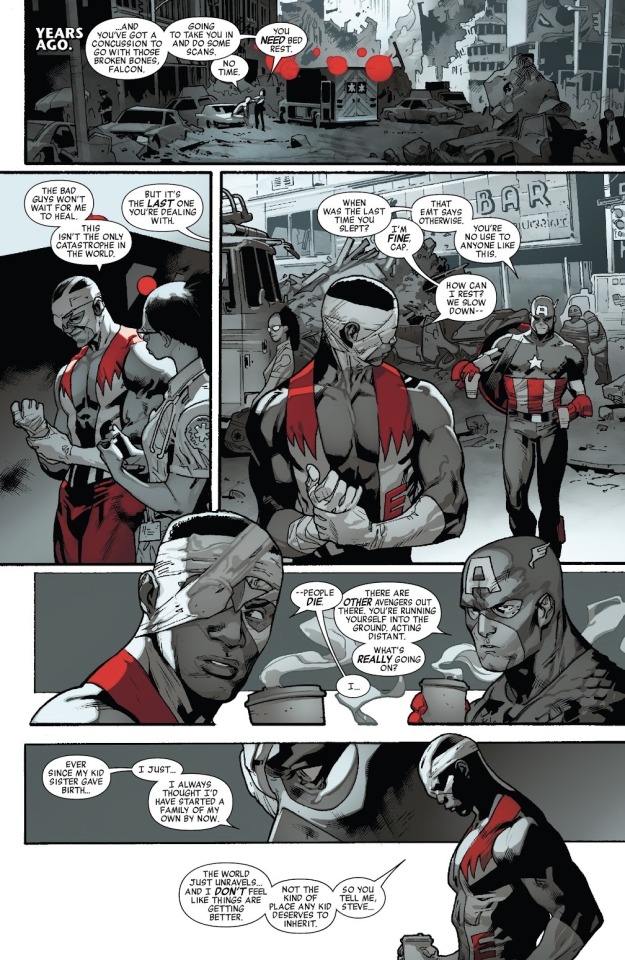



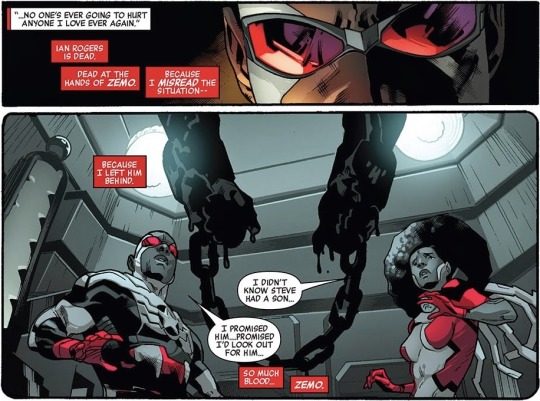





All-New Captain America (2015) #4 and #2-4 and #6
#this is super interesting#obviously Steve and Sharon are Ian’s parents and I’m not really much of a shipper anyway#and I don’t think Sam’s dynamic towards Ian is parental#but I find it really compelling how Ian is functioning as a stand-in for Sam’s non-existent child#both in Sam’s feelings about Steve and Ian’s relationship and how Ian represents a second generation there#but that there’s also a little bit of framework there because Sam cares about Ian because of his platonic love for Steve#which is reminiscent of Sam and Bucky’s partnership#where Bucky and Steve’s relationship was at times parental and Sam stepped up because of his love for Steve#and was Bucky’s friend and at times mentor#but I also really like- completely independent from Sam’s feelings about Steve- how what happens with Ian#functions as a way to get Sam to express long-standing feelings about having children#the other books I’ve read by Rick Remember- Captain America (2013) and Winter Soldier: The Bitter March (2014)- have all been#thematically really strong#I also like how Sam’s similar feelings about children and acknowledgment about Steve not being able to live the American dream for himself#because he was busy being Captain America#demonstrates how well Sam understands Steve#it makes me think of Captain America (2002) issue 4 when Steve thinks about that he wants to get married and have a child#but it’s his job to ‘hold’ [protect] the dream#‘It’s enough to hold it soldier- Hold the dream. You don’t have to taste it.’#and then later in Captain America (2002) issue 14 the idea is raised of Steve settling down#and he automatically responds ‘I’ve never felt anything was missing from my life sir.’#which is so in-character for him- to default to lying and acting like a perfect figure#I don’t assume that Steve talked about these feelings with Sam but that Sam just gets them because he understands that Steve is a person#and he understands Steve’s life enough to know how real person- and not an ideal figure- would feel in that situation#marvel#sam wilson#steve rogers#ian rogers#my posts#comic panels
8 notes
·
View notes
Text
Sent a message (they have a whole interface for it) to the guys I might have an "in" with for my internship (and updated my resume). Also called the guy running the tiny company that sounded delightful.
The company still sounded delightful, but unfortunately they're basically phasing out because the only one there is like eighty-years-old and he only works on legacy-projects (people with old systems who refuse to update their shit).
As in, listening to him, I kind of get the feeling that he doesn't exactly work 40-hour weeks, but more akin to "a few hours per month". Which obviously wouldn't work for an internship.
Which actually makes me a bit frustrated that I wasn't able to do this career-switch ten years ago, just so that I could do this specific internship. (Don't know how long he's been scaling things back, but yeah)
#basically. the company developed things in excel. as in they made customized frameworks with database-access for excel (and the like)#and i'm genuinely kind of disappointed bcs imagine. IMAGINE. if i could've jumped from all of my regular shit#to developing professional stuff in excel. just... always working with excel. from a dozen different angles and careers.#i can just imagine my mom's expression at realizing that i found a job that i'll no doubt delight in for years to come. and it's excel.#she'd be happy for me ofc. but also like. why is my child obsessed with excel? why.#personal stuff#school
2 notes
·
View notes
Text
literally saw a thing so badly phrased on story structure that any exhaustion I felt disappeared……. no way are we now misunderstanding structure to the point of making it sound like a quirky nice thing to add to a story pls don’t do this to me it is 5am if you wrote a story it has a structure & just bc that structure doesn’t begin with save and end in the fucking cat does not mean it is not a structure holy god !!!
#I am TIREDDDD#suggesting the criticisms of particular structure frameworks is bc ppl are criticizing story structure#that doesn’t even make sense I can’t even begin to express#BYE I NEED TO SLEEP LMAO
10 notes
·
View notes
Text
“If the situation were reversed” mfs when the situation is reversed:

#‘if it was a man abusing a woman he’d be thrown in jail’#1) be for fucking real. no he wouldn’t. why do they always say this.#the fact that they think everyone who gets accused of abuse actually gets punished for it is very telling#2) why do you still need to bring up the abuse of women in order to validate a male abuse victim. why is this the framework through which y#you see the world.#why is it still about how women would somehow benefit in this situation (which ftr they wouldn’t)#and frankly it’s disrespectful to the victim. like way to use their abuse story as a chance to express your bitterness towards women
4 notes
·
View notes
Text
yknow it's really frustrating when i start talking to someone, they clearly think i'm p cool and understand that i'm a leftist, and then i drop that im a physics major interested in the nuclear sector and suddenly assume that i must hate the humanities and love war crimes
#☢️.txt#we literally had a 20 minute convo about the value of fashion as self expression but apparently the fact that i like math means#i must not ACTUALLY care about that stuff!!!!#and if im pro nuclear energy clearly its bc i have bad opinions and not that i couldve actually yknow. came to that conclusion#both thru the framework of being an ML and someone who enjoys the science#also these types always hate it when i point out solar requires mining too#sorry guys. mining is an unfortunate reality!
6 notes
·
View notes
Text

Visualize Disciplines
Challenging Habits of Thought via Interdisciplinary Studies
The Cambridge Creation Lab (CCL) is an interdisciplinary institution that provides specialized education and training. If you are interested in setting up interdisciplinary educational concepts, organizational and professional development, and consultancy for both students and instructors, please feel free to seek help from the institute. The Cambridge Creation Lab's Interdisciplinary Courses department offers a dynamic platform and the opportunity to investigate the world through the convergence of various disciplines, thereby challenging the boundaries of traditional learning. Our courses not only focus on the theoretical aspects of interdisciplinary studies but also provide practical skills that are directly applicable in real-world scenarios. These practical skills, such as critical thinking, problem-solving, and effective communication, are essential for success in any professional field. History has demonstrated the extensive and profound historical origins of the concepts of interdisciplinarity, design, and creativity. The creative process is distinguished by the dynamic integration of mental representations and ideas that have not been previously investigated, whether they originate from memory or imagination. This process necessitates the integration of distinct modes of thought. Interdisciplinary studies are characterized by the utilization of a diverse array of academic disciplines to address intricate issues or inquiries that are beyond the scope of a single field of study. The process of interdisciplinary research allows us to combine knowledge and methods of thinking from various fields, resulting in cognitive advancement that will enable us to approach real-world problems from a unique perspective. By engaging in guided activities, completing written assignments, and having conversations, students will develop their capacity to conduct in-depth investigations on their chosen academic topics using various media. Our courses concentrate on the procedures and methodologies employed in numerous fields, enabling students to explore multiple research avenues and establish connections across a wide range of disciplines. Ultimately, this course serves as a vital catalyst for cognitive growth, equipping students with the tools necessary for innovative problem-solving in an increasingly complex world. By honing their ability to conduct thorough investigations through diverse media, learners deepen their understanding and cultivate a versatile skill set applicable across various fields. The emphasis on procedural methodologies fosters a structured research approach, empowering students to navigate and explore multiple avenues while establishing meaningful connections across disciplines. This multifaceted learning experience enriches individual knowledge and prepares participants to tackle real-world challenges with creativity and insight.
#Interdisciplinary studies#Projects#Thinking frameworks#Academic fields#Creative education#Cognitive process#express thoughts#ideas from imagination#convergence of diverse disciplines#Notions of creativity
0 notes
Text
in conversations about sex education for children many people fall back on teaching children to recognize and, hopefully, report predatory behavior as the primary reason why this education is good, and obviously I don't disagree with that! when I educate my 4th-6th students, we spend a significant amount of time talking about boundaries and consent and drilling in to the kids' brains that they do NOT need to tolerate inappropriate touching or other behavior from anyone, not even adults who might try to pressure them into thinking otherwise.
BUT! but but but! I think it's also really important to remember that preparing for the worst case scenario isn't the only reason to educate kids about sexuality and their bodies! kids deserve to enter puberty understanding all of the changes they'll experience, and not just the growing and sweating. it's good for kids to understand the new desires they might start experiencing! it's good to know about intense new crushes and erections and wet dreams and sexual fantasies and masturbation! those things can be really, really scary and confusing for young people who don't have any framework to understand them, and it's really easy to feel like you're doing something dirty and inappropriate if no one has told you that sexual pleasure and curiosity is normal, healthy, and good.
good sex ed should help students feel comfortable and safe expressing their sexuality! that's crucial!
8K notes
·
View notes
Text
#mern stack developer#web services#mongodb#express#Express#React#Node js#Mern stack programmer#framework
0 notes
Text
Writing References: Character Development
50 Questions ⚜ Backstory ⚜ Character-driven Story
Basics: How to Write a Character ⚜ A Story-Worthy Hero
Basics: Character-Building ⚜ Character Creation
Types of Characters: Key Characters ⚜ Literary Characters ⚜ Flat & Round Characters ⚜ Morally Grey ⚜ Narrators ⚜ Allegorical Characters ⚜ Archetypes ⚜ Stereotypical Characters
Worksheets: Backstory ⚜ Character ⚜ Kill your Characters ⚜ Antagonist; Villain; Fighting ⚜ Change; Adding Action; Conflict ⚜ Character Sketch & Bible ⚜ Protagonist & Antagonist ⚜ Name; Quirks; Flaws; Motivation ⚜ "Interviewing" your Characters ⚜ "Well-Rounded" Character
Personality Traits
5 Personality Traits (OCEAN) ⚜ 16 Personality Traits (16PF)
600+ Personality Traits ⚜ 170 Quirks
East vs. West Personalities ⚜ Trait Theories
Tips/Editing
Character Issues ⚜ Character Tropes for Inspiration
"Strong" Characters ⚜ Unlikable to Likable
Tips from Rick Riordan
Writing Notes
Binge ED ⚜ Hate ⚜ Love ⚜ Identifying Character Descriptions
Childhood Bilingualism ⚜ Children's Dialogue ⚜ On Children
Culture ⚜ Culture: Two Views ⚜ Culture Shock
Dangerousness ⚜ Flaws ⚜ Fantasy Creatures
Emotional Intelligence ⚜ Genius (Giftedness)
Emotions (1) (2) ⚜ Anger ⚜ Fear ⚜ Happiness ⚜ Sadness
Emotional Universals ⚜ External & Internal Journey
Goals & Motivations ⚜ Grammar Development ⚜ Habits
Facial Expressions ⚜ Jargon ⚜ Swearing & Taboo Expressions
Happy/Excited Body Language ⚜ Laughter & Humor
Health ⚜ Frameworks of Health ⚜ Memory
Mutism ⚜ Shyness ⚜ Parenting Styles ⚜ Generations
Psychological Reactions to Unfair Behavior
Rhetoric ⚜ The Rhetorical Triangle ⚜ Logical Fallacies
Thinking ⚜ Thinking Styles ⚜ Thought Distortions
Uncommon Words: Body ⚜ Emotions
Villains ⚜ Voice & Accent
More References: Plot ⚜ World-building ⚜ Writing Resources PDFs
#writing reference#character building#writing tips#writing advice#character inspiration#writeblr#dark academia#spilled ink#literature#writing prompt#creative writing#fiction#writers on tumblr#story#novel#light academia#writing resources#compilation requested by anon#still a bit messy & incomplete - will edit soon#will also update this every few weeks/months
12K notes
·
View notes
Text
Australia Visa Subclass 189: Your Pathway to Permanent Residency
Are you a skilled professional considering a move to Australia? The Subclass 189 Skilled Independent Visa might be the perfect solution for you. This visa offers an opportunity for individuals to gain permanent residency in Australia, enabling them to live and work in one of the world’s most vibrant economies.

Here’s an overview of what you need to know:
What is the Subclass 189 Visa? The Subclass 189 visa is designed for skilled workers who wish to migrate to Australia independently, without the need for employer sponsorship. It allows successful applicants to live and work in Australia permanently, contributing to the nation’s dynamic labor market.
Key Benefits of the Subclass 189 Visa Permanent Residency:
This visa grants the right to reside in Australia indefinitely.
Unrestricted Work Rights: Visa holders can work in any occupation, offering maximum flexibility. Family Inclusion: Applicants can include immediate family members, ensuring a smooth transition for loved ones.
Access to Education: Children can enroll in public schools, and visa holders can pursue higher education at domestic tuition rates.
Healthcare Access: Permanent residents benefit from Australia’s Medicare system, ensuring access to essential healthcare services.
Pathway to Citizenship: After fulfilling residency requirements, visa holders can apply for Australian citizenship, opening the door to further benefits.
Eligibility Criteria To qualify for the Subclass 189 visa, applicants must meet the following requirements:
Age: Must be under 45 years old at the time of receiving an invitation to apply. Skilled Occupation: Must nominate an occupation listed on the Skilled Occupation List (SOL).
Skills Assessment: A positive skills assessment from a designated authority is required.
Points-Based System: Applicants must score at least 65 points based on factors such as age, English language proficiency, education, and work experience.
Health and Character Requirements: Applicants must pass health checks and provide police clearance certificates.
Application Process Skills Assessment: Begin by obtaining a positive skills assessment for your nominated occupation.
Expression of Interest (EOI): Submit an EOI through the SkillSelect platform, detailing your qualifications and points score.
Invitation to Apply (ITA): High-scoring candidates will receive an ITA for the visa.
Visa Application Submission: After receiving the ITA, submit a comprehensive visa application, including all necessary documentation and fees.
Health and Character Checks: Undergo medical examinations and provide police clearance certificates.
Await Outcome: The Department of Home Affairs will assess your application and communicate the outcome.
Conclusion The Subclass 189 Skilled Independent Visa is a valuable opportunity for skilled professionals looking to secure a prosperous future in Australia. With its numerous benefits and straightforward application process, it paves the way for a rewarding life in a country known for its high quality of life and diverse culture. If you're ready to take the next step toward your Australian dream, conduct thorough research, and consider consulting with immigration professionals to navigate the complexities of the application process. Embark on your journey today! For more information, visit www.abroadpathway.com.
#Australia Visa Subclass 189#Skilled Independent Visa#Permanent residency#Skilled Occupation List (SOL)#Employment autonomy#Healthcare access#Medicare#Family reunion provisions#Pathway to citizenship#Eligibility criteria#Age requirement#Skills assessment#Points-based assessment#English language proficiency#Expression of Interest (EOI)#Invitation to Apply (ITA)#Application process#Lodging the visa application#Documentation#Health and character checks#Processing timeline#Cost of living#Employment landscape#Educational framework#Quality of life metrics#Community resources#Migration pathway#International qualifications#Visa application fees#Comprehensive research
0 notes
Text
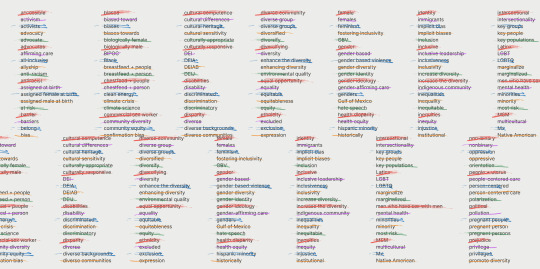
The words they're afraid of.
(Read on our blog.)
The recently appointed Department of Defense head Pete Hegseth (formerly Fox News pundit, perpetually soused creepy uncle, and current group chat leaker of classified intel) banned images of the Enola Gay from the Pentagon’s website for the offense of “DEI” language. In keeping with the far right’s stated war on anything vaguely resembling diversity, equity and inclusion, even historical photos are up for cancellation. When a literal weapon of mass destruction is censored for being a bit fruity under the Trump administration’s war against inconvenient truths, what exactly is left untouched?
This is clown show stuff, but the stakes are far from funny. While some might be hesitant to compare the current administration to the very worst history has to offer, we can at least all agree that they are dyed-in-the-wool grammar Nazis. Policing language has been the objective of the MAGA culture war long before Project 2025’s debut—the wave of book bans orchestrated by astroturf movements like Moms for Liberty, and Florida’s 2022 Don’t Say Gay bill have already had a profound effect in the arena of free speech and freedom of expression (despite the far right’s long tradition of doublespeak performative free-speech martyrdom to the contrary). Don’t Say Gay ostensibly targeted K-3 education, but LGBT+ content at all levels of education (and beyond) was either quietly censored or entirely preempted in practice. The results were not just a war on so-called ideology, or words alone—but on reality and essential freedoms.
Now, words as innocuous and important as racism, climate change, hate speech, prejudice, mental health, and inequality are targeted as subversive. Entire concepts are being vanished from government institutions, scrubbed not only from descriptions but from metadata, search indexes, and archival frameworks.
If you don’t name a thing, does it exist?
These words are as numerous as they are generic: women, race, Black, immigrants, multicultural, gender, injustice. But what is painfully unserious is also particularly dangerous in its real-world consequences. The process of controlling words is a well-worn authoritarian tendency. Fifty-two universities are now under investigation as part of the President's effort to curb “woke” research and thought crimes. Institutions are being coerced to comply with a nebulous set of ideological demands, or face budgetary annihilation. That means cutting funding for entire departments, slashing financial aid, defunding scientific grants, and pressuring faculty to self-censor.
The possibilities for censorship extend far and wide—interfering, by extension, in everything from reproductive healthcare programs, to libraries and museums. The Trump administration’s proposed budget slashing all federal funding for libraries, including the Institute of Museum and Library Services, will effectively gut an infrastructure that supports over 100,000 libraries and museums across the country—community centers, educational lifelines, internet access points, and archives of marginalized histories (starting with the Smithsonian Institution).
When you erase access, you erase participation. And when you erase participation, you erase people, and the means by which future generations might even learn they existed. A culture that cannot remember is a culture that cannot resist.
The erasure is, yet again, unsurprisingly targeted at minorities and LGBT+ people. The National Parks Service quietly revised the Stonewall Monument’s website to remove references to transgender people—a fundamental part of the original protests. Not an oversight, not a mistake, but a deliberate excision—one point in a wider plan of erasure depicted in stark detail in Project 2025, a blueprint to dismantle civil rights, defund LGBT+-related healthcare, and rewrite history from the ground up.
Dehumanization by deletion—welcome to the reactionary resurgence of doubleplusungood governance. In Trumpland, words are weapons—but not in the way they intend. Their fear of language betrays its power; that’s why they’re trying so hard to police it.
Words hurt them.
Hurt them back.

- the Ellipsus Team
#writeblr#writers on tumblr#writing#fiction#fanfic#fanfiction#us politics#american politics#lgbtq community#lgbtq rights#trans rights#freedom of expression#censorship#writers#writerscommunity#creative writing
3K notes
·
View notes
Text
Ralsei has known what's been going on with Kris the ENTIRE time, and once you realise that, EVERYTHING he says and does around them makes a thousand times more sense. And you realise that, far from dismissing Kris's "true" self in favour of a copy, he has been working tirelessly to prop them up, to validate their most basic and fundamental choices, to keep them from the brink of despair, and perhaps even death.
We always thought it was strange, how Ralsei seems to baby Kris at times - how he offers heaps of praise upon them for performing the simplest of tasks, how he lets them express themself through violence while chastising Susie for the same thing, how at every turn he puts so much emphasis on Kris's choices, their talents, their intrinsic personhood, almost above the very prophecy he serves. We thought him mollycoddling and completely out-of-touch at best, and downright malicious at worst. We presumed he was encouraging the player to keep playing, and was in fact speaking over Kris's head directly at us. We presumed that the prophecy was all he cared about, and him encouraging Kris was simply a means to that end.
And we were wrong about all of it. Because we didn't know what Kris was truly going through until now. We thought that our possession was the worst thing that was happening to them, and that he was complicit in their suffering by trying to downplay it.
But Ralsei knew. Because Ralsei knows Kris better than anyone else - better than Susie, better than Noelle, and certainly far better than us.
Kris is hopelessly trapped, at all times. There is no hope for them, they cannot see a way to escape their bonds... not alive, in any case. Their suffering is so great, the pressures upon them so immense, that they have been hollowed out into a catatonic shell of their former self - unable to move except through great effort, unable to speak except through stilted phrases. They don't sleep or eat well at all. They don't try at school. They cannot tell anyone about what's happening, and they cannot make friends because of it. For all intents and purposes, they have given up.
But it's worse than that, because they KNOW that what they're being made to do is wrong. They don't want to do any of it, and yet they feel they cannot refuse. That knowledge eats away at them, to the point where they feel like they are inherently Bad, because only Bad people do Bad things, and they're doing Bad things all the time. They don't feel like they deserve the good things in their life because of it. They feel like they're living a lie. And no-one else knows - no-one else can possibly know.
But Ralsei knows.
Why does Ralsei go to the trouble of arranging a tutorial battle for Kris, when they've already demonstrated their capabilities fighting against Lancer? Because Kris doesn't know what they're doing during that fight. They're issuing commands, fighting alongside Susie, and they don't know how or why. They're scared, they don't know where they are, and the one other person they knew from school just ditched them. Through the tutorial, Ralsei breaks down each combat function step-by-step, walking Kris through each one with patience and restraint. And he lets them go off-piste up to a point - he'll let them attack his mannequin and say it's alright if they want to hit him too, he'll let them hug him several times throughout the tutorial, and he will show remarkable restraint throughout the entire endeavour, despite his obvious frustration at their uncooperativeness.
Seen this way, the Tutorial becomes less about the GAME teaching the PLAYER how to battle, and more about RALSEI providing to KRIS some semblance of structure and context to a new and frightening world. Both of them are literally starting at Zero, and have to establish the basics before anything further can happen.
This in turn establishes the framework for their relationship - not an annoying tutorial fairy lecturing an experienced player on things they already know, but a kindly tutor gently guiding a broken teen, one tiny step at a time. Not lashing out at mistakes, not admonishing when they try to assert themself against the established framework - he will let them fight, and let them command him to fight as well, because his desire to help Kris find themself again means he has to provide leeway for if they "misbehave". There have to be bounds, but they must feel like the choices they make matter - even if they actually don't.
When you're drowning in a world that has seemingly conspired to take your agency from you, and break you down into nothing more than a pawn that does what it's told and nothing else... even the illusion of choice is a life-preserver that you'll cling onto for dear life. The support Ralsei provides Kris in this capacity is what gives them the drive to protect Susie from King's attack - to make a choice to protect their friend, even if it wouldn't have meaningfully changed anything.
It explains his secret conversations with Kris too - while we are busy watching Susie, Ralsei is free to let Kris know that despite being literally controlled, the one controlling them is on their side, and that we will help them break free from the more insidious influence of the Knight. He has to tell them to trust in us, trust that we will do right by them to the best of our abilities. And indeed, by Chapter 2, they have become more willing to express themself through their tone of voice, through how they choose to interpret the instructions given to us, either to play pranks or to show their appreciation for the people who, despite everything, still care for them.
And even Ralsei's apparent dismissive attitude to Spamton NEO's effect on Kris can be explained through this prism. Kris is very very slowly starting to recover from the trauma of their situation, and literally EVERYTHING about Spamton is a huge trigger for them. It's not farfetched to say that Kris sees in Spamton a cautionary tale of how they will end up - used up, cast aside, wretched and desperate and bitter and broken. All of Ralsei's work building Kris back up could be undone in an instant, and so he has to tread extremely carefully - downplay its significance, offer nonthreatening proximity (he will hug Kris, but only if they hugged him on the boat ride prior to this), distract them from the immediate trauma with very basic "nice" thinks like cake, and warm/soft things. It seems dismissive at the time because we don't yet know what Spamton truly represents to Kris - not just the fear of being controlled against your will, but of being used up and broken down, and then tossed away like an unloved toy. It's only when we have that additional context that all of Ralsei's actions towards them start to make sense - not only make sense, but also show a level of care and tact that we did not previously assume him capable of.
And I suppose the last question is: why does Ralsei do any of this in the first place? Why go to this trouble when he knows he'll just be left behind, when he knows that if he succeeds, Kris will go back to the light world and live a full life without him? Well... look at the colour of his horns. If Ralsei is the horned headband, and Kris wore him for months, he would have borne witness to Kris's deepest, darkest fears about themself. It's possible that he might have seen the inciting incident that led Kris down this unfortunate path. Either way, he would have been so close to them that he'd almost be like an extension of them.
So, again - why does he do this? Because his purpose was always to guide them back to themself - first as a pair of horns to better fit in with their family, and then as a physical manifestation of those same horns to help them overcome the terrible harm that has been wrought upon them.
But more than this, I think it's because he loves them - the same way that they would have loved him when they wore him all those years ago. And isn't that what you do for the people you love - help them when they're struggling, comfort them when they're sad, gently challenge them to expand their window of tolerance, give them the tools they need to return to the light, to heal and grow back into themselves?
Ralsei knows Kris better than anyone else. And maybe we should start listening to him.
#deltarune#deltarune spoilers#ralsei#ralsei deltarune#kris dreemurr#kris deltarune#character study#deltarune analysis#patchworkthinks#long post
2K notes
·
View notes
Text
AutoBNN: Probabilistic time series forecasting with compositional bayesian neural networks
New Post has been published on https://thedigitalinsider.com/autobnn-probabilistic-time-series-forecasting-with-compositional-bayesian-neural-networks/
AutoBNN: Probabilistic time series forecasting with compositional bayesian neural networks
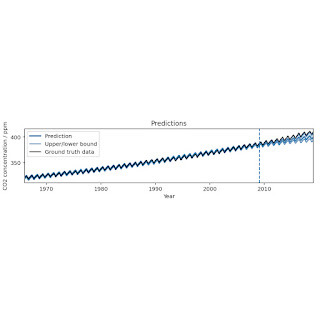
Posted by Urs Köster, Software Engineer, Google Research

Time series problems are ubiquitous, from forecasting weather and traffic patterns to understanding economic trends. Bayesian approaches start with an assumption about the data’s patterns (prior probability), collecting evidence (e.g., new time series data), and continuously updating that assumption to form a posterior probability distribution. Traditional Bayesian approaches like Gaussian processes (GPs) and Structural Time Series are extensively used for modeling time series data, e.g., the commonly used Mauna Loa CO2 dataset. However, they often rely on domain experts to painstakingly select appropriate model components and may be computationally expensive. Alternatives such as neural networks lack interpretability, making it difficult to understand how they generate forecasts, and don’t produce reliable confidence intervals.
To that end, we introduce AutoBNN, a new open-source package written in JAX. AutoBNN automates the discovery of interpretable time series forecasting models, provides high-quality uncertainty estimates, and scales effectively for use on large datasets. We describe how AutoBNN combines the interpretability of traditional probabilistic approaches with the scalability and flexibility of neural networks.
AutoBNN
AutoBNN is based on a line of research that over the past decade has yielded improved predictive accuracy by modeling time series using GPs with learned kernel structures. The kernel function of a GP encodes assumptions about the function being modeled, such as the presence of trends, periodicity or noise. With learned GP kernels, the kernel function is defined compositionally: it is either a base kernel (such as Linear, Quadratic, Periodic, Matérn or ExponentiatedQuadratic) or a composite that combines two or more kernel functions using operators such as Addition, Multiplication, or ChangePoint. This compositional kernel structure serves two related purposes. First, it is simple enough that a user who is an expert about their data, but not necessarily about GPs, can construct a reasonable prior for their time series. Second, techniques like Sequential Monte Carlo can be used for discrete searches over small structures and can output interpretable results.
AutoBNN improves upon these ideas, replacing the GP with Bayesian neural networks (BNNs) while retaining the compositional kernel structure. A BNN is a neural network with a probability distribution over weights rather than a fixed set of weights. This induces a distribution over outputs, capturing uncertainty in the predictions. BNNs bring the following advantages over GPs: First, training large GPs is computationally expensive, and traditional training algorithms scale as the cube of the number of data points in the time series. In contrast, for a fixed width, training a BNN will often be approximately linear in the number of data points. Second, BNNs lend themselves better to GPU and TPU hardware acceleration than GP training operations. Third, compositional BNNs can be easily combined with traditional deep BNNs, which have the ability to do feature discovery. One could imagine “hybrid” architectures, in which users specify a top-level structure of Add(Linear, Periodic, Deep), and the deep BNN is left to learn the contributions from potentially high-dimensional covariate information.
How might one translate a GP with compositional kernels into a BNN then? A single layer neural network will typically converge to a GP as the number of neurons (or “width”) goes to infinity. More recently, researchers have discovered a correspondence in the other direction — many popular GP kernels (such as Matern, ExponentiatedQuadratic, Polynomial or Periodic) can be obtained as infinite-width BNNs with appropriately chosen activation functions and weight distributions. Furthermore, these BNNs remain close to the corresponding GP even when the width is very much less than infinite. For example, the figures below show the difference in the covariance between pairs of observations, and regression results of the true GPs and their corresponding width-10 neural network versions.
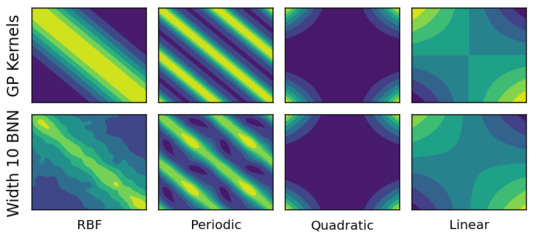
Comparison of Gram matrices between true GP kernels (top row) and their width 10 neural network approximations (bottom row).
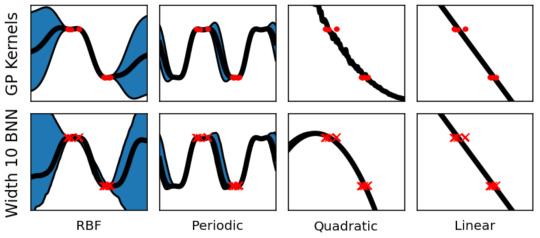
Comparison of regression results between true GP kernels (top row) and their width 10 neural network approximations (bottom row).
Finally, the translation is completed with BNN analogues of the Addition and Multiplication operators over GPs, and input warping to produce periodic kernels. BNN addition is straightforwardly given by adding the outputs of the component BNNs. BNN multiplication is achieved by multiplying the activations of the hidden layers of the BNNs and then applying a shared dense layer. We are therefore limited to only multiplying BNNs with the same hidden width.
Using AutoBNN
The AutoBNN package is available within Tensorflow Probability. It is implemented in JAX and uses the flax.linen neural network library. It implements all of the base kernels and operators discussed so far (Linear, Quadratic, Matern, ExponentiatedQuadratic, Periodic, Addition, Multiplication) plus one new kernel and three new operators:
a OneLayer kernel, a single hidden layer ReLU BNN,
a ChangePoint operator that allows smoothly switching between two kernels,
a LearnableChangePoint operator which is the same as ChangePoint except position and slope are given prior distributions and can be learnt from the data, and
a WeightedSum operator.
WeightedSum combines two or more BNNs with learnable mixing weights, where the learnable weights follow a Dirichlet prior. By default, a flat Dirichlet distribution with concentration 1.0 is used.
WeightedSums allow a “soft” version of structure discovery, i.e., training a linear combination of many possible models at once. In contrast to structure discovery with discrete structures, such as in AutoGP, this allows us to use standard gradient methods to learn structures, rather than using expensive discrete optimization. Instead of evaluating potential combinatorial structures in series, WeightedSum allows us to evaluate them in parallel.
To easily enable exploration, AutoBNN defines a number of model structures that contain either top-level or internal WeightedSums. The names of these models can be used as the first parameter in any of the estimator constructors, and include things like sum_of_stumps (the WeightedSum over all the base kernels) and sum_of_shallow (which adds all possible combinations of base kernels with all operators).

Illustration of the sum_of_stumps model. The bars in the top row show the amount by which each base kernel contributes, and the bottom row shows the function represented by the base kernel. The resulting weighted sum is shown on the right.
The figure below demonstrates the technique of structure discovery on the N374 (a time series of yearly financial data starting from 1949) from the M3 dataset. The six base structures were ExponentiatedQuadratic (which is the same as the Radial Basis Function kernel, or RBF for short), Matern, Linear, Quadratic, OneLayer and Periodic kernels. The figure shows the MAP estimates of their weights over an ensemble of 32 particles. All of the high likelihood particles gave a large weight to the Periodic component, low weights to Linear, Quadratic and OneLayer, and a large weight to either RBF or Matern.
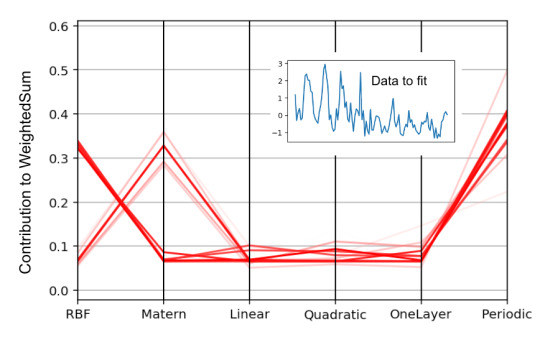
Parallel coordinates plot of the MAP estimates of the base kernel weights over 32 particles. The sum_of_stumps model was trained on the N374 series from the M3 dataset (insert in blue). Darker lines correspond to particles with higher likelihoods.
By using WeightedSums as the inputs to other operators, it is possible to express rich combinatorial structures, while keeping models compact and the number of learnable weights small. As an example, we include the sum_of_products model (illustrated in the figure below) which first creates a pairwise product of two WeightedSums, and then a sum of the two products. By setting some of the weights to zero, we can create many different discrete structures. The total number of possible structures in this model is 216, since there are 16 base kernels that can be turned on or off. All these structures are explored implicitly by training just this one model.
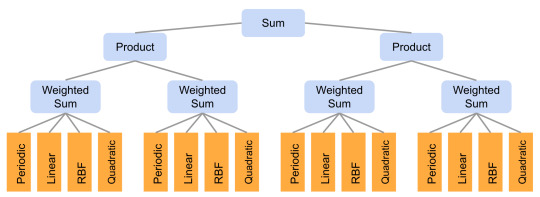
Illustration of the “sum_of_products” model. Each of the four WeightedSums have the same structure as the “sum_of_stumps” model.
We have found, however, that certain combinations of kernels (e.g., the product of Periodic and either the Matern or ExponentiatedQuadratic) lead to overfitting on many datasets. To prevent this, we have defined model classes like sum_of_safe_shallow that exclude such products when performing structure discovery with WeightedSums.
For training, AutoBNN provides AutoBnnMapEstimator and AutoBnnMCMCEstimator to perform MAP and MCMC inference, respectively. Either estimator can be combined with any of the six likelihood functions, including four based on normal distributions with different noise characteristics for continuous data and two based on the negative binomial distribution for count data.

Result from running AutoBNN on the Mauna Loa CO2 dataset in our example colab. The model captures the trend and seasonal component in the data. Extrapolating into the future, the mean prediction slightly underestimates the actual trend, while the 95% confidence interval gradually increases.
To fit a model like in the figure above, all it takes is the following 10 lines of code, using the scikit-learn–inspired estimator interface:
import autobnn as ab model = ab.operators.Add( bnns=(ab.kernels.PeriodicBNN(width=50), ab.kernels.LinearBNN(width=50), ab.kernels.MaternBNN(width=50))) estimator = ab.estimators.AutoBnnMapEstimator( model, 'normal_likelihood_logistic_noise', jax.random.PRNGKey(42), periods=[12]) estimator.fit(my_training_data_xs, my_training_data_ys) low, mid, high = estimator.predict_quantiles(my_training_data_xs)
Conclusion
AutoBNN provides a powerful and flexible framework for building sophisticated time series prediction models. By combining the strengths of BNNs and GPs with compositional kernels, AutoBNN opens a world of possibilities for understanding and forecasting complex data. We invite the community to try the colab, and leverage this library to innovate and solve real-world challenges.
Acknowledgements
AutoBNN was written by Colin Carroll, Thomas Colthurst, Urs Köster and Srinivas Vasudevan. We would like to thank Kevin Murphy, Brian Patton and Feras Saad for their advice and feedback.
#Advice#Algorithms#Blue#Building#classes#CO2#code#CoLab#Combinatorial#Community#comparison#continuous#data#datasets#direction#economic#Engineer#express#financial#flax#form#framework#Future#Google#GPS#gpu#Hardware#hardware acceleration#how#hybrid
0 notes
Text

Interdisciplinary Dialogues
Challenging Habits of Thought via Interdisciplinary Studies
The Cambridge Creation Lab (CCL) is an interdisciplinary institution that provides specialized education and training. If you are interested in setting up interdisciplinary educational concepts, organizational and professional development, and consultancy for both students and instructors, please feel free to seek help from the institute. The Cambridge Creation Lab's Interdisciplinary Courses department offers a dynamic platform and the opportunity to investigate the world through the convergence of various disciplines, thereby challenging the boundaries of traditional learning. Our courses not only focus on the theoretical aspects of interdisciplinary studies but also provide practical skills that are directly applicable in real-world scenarios. These practical skills, such as critical thinking, problem-solving, and effective communication, are essential for success in any professional field. History has demonstrated the extensive and profound historical origins of the concepts of interdisciplinarity, design, and creativity. The creative process is distinguished by the dynamic integration of mental representations and ideas that have not been previously investigated, whether they originate from memory or imagination. This process necessitates the integration of distinct modes of thought. Interdisciplinary studies are characterized by the utilization of a diverse array of academic disciplines to address intricate issues or inquiries that are beyond the scope of a single field of study. The process of interdisciplinary research allows us to combine knowledge and methods of thinking from various fields, resulting in cognitive advancement that will enable us to approach real-world problems from a unique perspective. By engaging in guided activities, completing written assignments, and having conversations, students will develop their capacity to conduct in-depth investigations on their chosen academic topics using various media. Our courses concentrate on the procedures and methodologies employed in numerous fields, enabling students to explore multiple research avenues and establish connections across a wide range of disciplines. Ultimately, this course serves as a vital catalyst for cognitive growth, equipping students with the tools necessary for innovative problem-solving in an increasingly complex world. By honing their ability to conduct thorough investigations through diverse media, learners deepen their understanding and cultivate a versatile skill set applicable across various fields. The emphasis on procedural methodologies fosters a structured research approach, empowering students to navigate and explore multiple avenues while establishing meaningful connections across disciplines. This multifaceted learning experience enriches individual knowledge and prepares participants to tackle real-world challenges with creativity and insight.
#Interdisciplinary studies#Projects#Thinking frameworks#Academic fields#Creative education#Cognitive process#express thoughts#ideas from imagination#convergence of diverse disciplines
0 notes